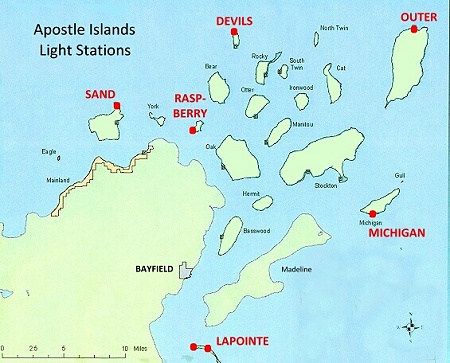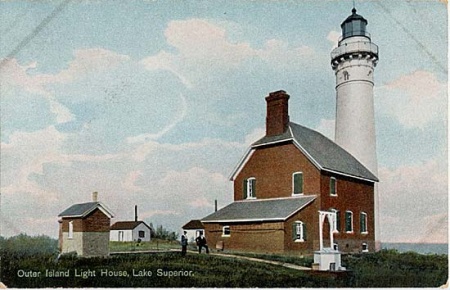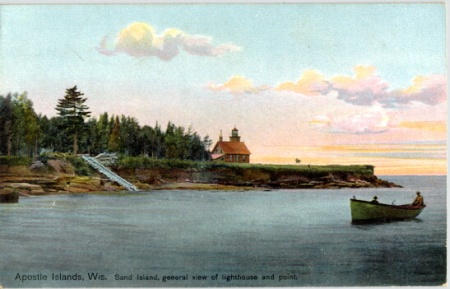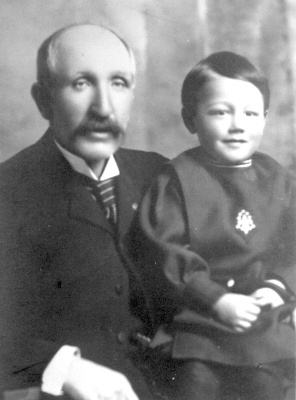The Day The Ships Went Down
Part Two
Return to Part One
Off Outer Island
The Pretoria, meanwhile, was facing an equally perilous
situation. Struggling against the gale, the barge and her towing
steamer had managed to pass some 30 miles beyond the Apostles when
calamity struck: her steering gear failed. The Venezuela changed
course and began an effort to tow the disabled Pretoria back to
shelter in the lee of the islands. It was a desperate maneuver in the
wild seas, and it failed: the heavy towline snapped under the strain,
and the howling wind quickly swept the mammoth ship out of sight. The Venezuela turned back to search for her consort, but she was gone.
For several hours, the great ship drifted helplessly in the
waves.

The great ships sank at opposite ends of the archipelago,
off Sand and Outer Islands.
Off Sand Island
The Sevona inched its way through the waves at slow speed.
Suddenly, though, there was a grinding jolt. Chief Engineer William
Phillippi recalled the moment:
"I received a signal from the captain to check the speed but
after she struck I received no more signals and I stopped the engine.
There were three distinct shocks and crashes, then the boat came to a
stand and broke in two. We blew the whistle for help until our fires
were put out."
Conditions aboard the grounded Sevona were desperate. The force
of the crash had split the boat in half. In the bow portion were the
captain and the officers; all of the experienced seamen. In the after
section were the engine-room crew, the passengers... and both of the
ship's lifeboats.
One of the passengers, Kate Spencer, described the scene:
"We got into the life boat at that time, but the captain and the
men could not come aft owing to the break. He hailed us through the
megaphone 'Hang on as long as you can.' We did so, but the sea was
pounding so hard, that we finally got out of the small boat, and into
the large vessel again, all congregating in the dining room which was
still intact.
"The big boat was pounding and tossing. Now a piece of the deck
would go, then a portion of the dining room, in which we were
quartered. During all this time, the men forward could not get to us.
Finally, at 11 o'clock everything seemed to be breaking at once, and
by order of the chief engineer, we took to the small boat again.
"One by one we piled into the boat, leaving six men behind us. I
never heard such a heart-rending cry as came from those six. 'For
God's sake don't leave us,' they cried.
Off Outer Island
What of the drifting Pretoria?
A newspaper account published two days later tells the tale:
"The Pretoria had a sail up forward, but the wind blew it to
ribbons. She was helpless in the trough of the sea. The waves
washed over her, and the wind was driving her in the direction of
Outer Island. The pumps were set at work but they gave out and the
anchor was dropped in 180 fathoms. It dragged some distance, but at
last brought up one and one half miles from the island and held.
"The seas pounded the distressed barge furiously. Water got into
the hold through the hatch combings.. the hatches came off and the
water poured into the hold. Then the covering board gave way and the
decks began to float off."
The crew of ten had only one hope: launch the lifeboat and head
through the storm to Outer Island.

Postcard view of Outer Island Lighthouse
Off Sand Island
Stirred by the cries of their shipmates, several sailors set
their own safety aside and returned to help their comrades launch the
balky port lifeboat.
Now, two small boats pulled away from the dying Sevona; six in
one, eleven in the other. The port boat, with six aboard, headed
straight for Sand Island, where they made a successful landing and
quickly found shelter with fisherman Fred Hansen. Engineer
Phillippi, on the other boat, directed a valiant, but fruitless
attempt to rescue the men stranded on the forward section. Turning
finally toward the mainland, the lifeboat tossed in the waves for six
full hours before reaching shore at Little Sand Bay.
This was wild country in those days, but the castaways were lucky
to meet a farmer out looking for a lost cow. He led them to a
logger's cabin where they could rest and warm up. As soon as he
gathered strength, Phillippi set out by horse and wagon for Bayfield,
to seek aid for the seven men remaining on the wreck. It took him
nearly a full day to travel the eleven miles through the rough
country.
By the time he arrived, his comrades' fate was already sealed.
Working feverishly on the battered deck, Captain MacDonald and his
six companions improvised a raft from several hatch covers. When it
seemed the ship was about to break up, they launched the makeshift
craft and made for the island. It broke apart as they neared shore,
and all seven drowned in the surf.

Postcard view of Sand Island Lighthouse
On Outer Island
From his perch atop the Outer Island lighthouse, keeper John
Irvine could see the Pretoria's lifeboat pulling away. His dry words
in the lighthouse logbook recounts the scene:
"September 2- A terrible gale blowing from the NE, the biggest
sea that I have seen since I have been at the station, which is eight
years. About 2:30 PM, sighted a Schooner at anchor about two miles NE
of Station. About 4 PM seen small boat leaving Schooner."
Irvine was alone in the lighthouse that day; both his assistants
had gone to the mainland before the storm struck. At sixty-one years
of age, Irvine was not a young man. Born in the Orkney Islands of
Scotland, he'd come to the U.S. as a child and served with the Union
Army in the Civil War. He went to sea after the war, and spent years
as sailor himself before entering the Lighthouse Service.
Perhaps it was a sense of kinship with the desperate men in the
lifeboats that guided his next move. Grabbing a signal flag and a
rope, Irvine raced down the steep stairs from the lighthouse grounds
to the beach.
The sailors pulled at their oars, making slow progress against
wind and wave, painfully making their way to safety. Then, five
hundred feet from shore, the boat capsized, tossing the men every
which way. Five of the sailors were washed away to their doom; five
were able to hold on to the hull. As the overturned boat neared the
beach, Keeper Irvine did not hesitate. Wading out into the breakers,
he pulled the five men to shore, one by one.

Outer Island keeper John Irvine
with grandson, 1905
Continue to Part Three
|